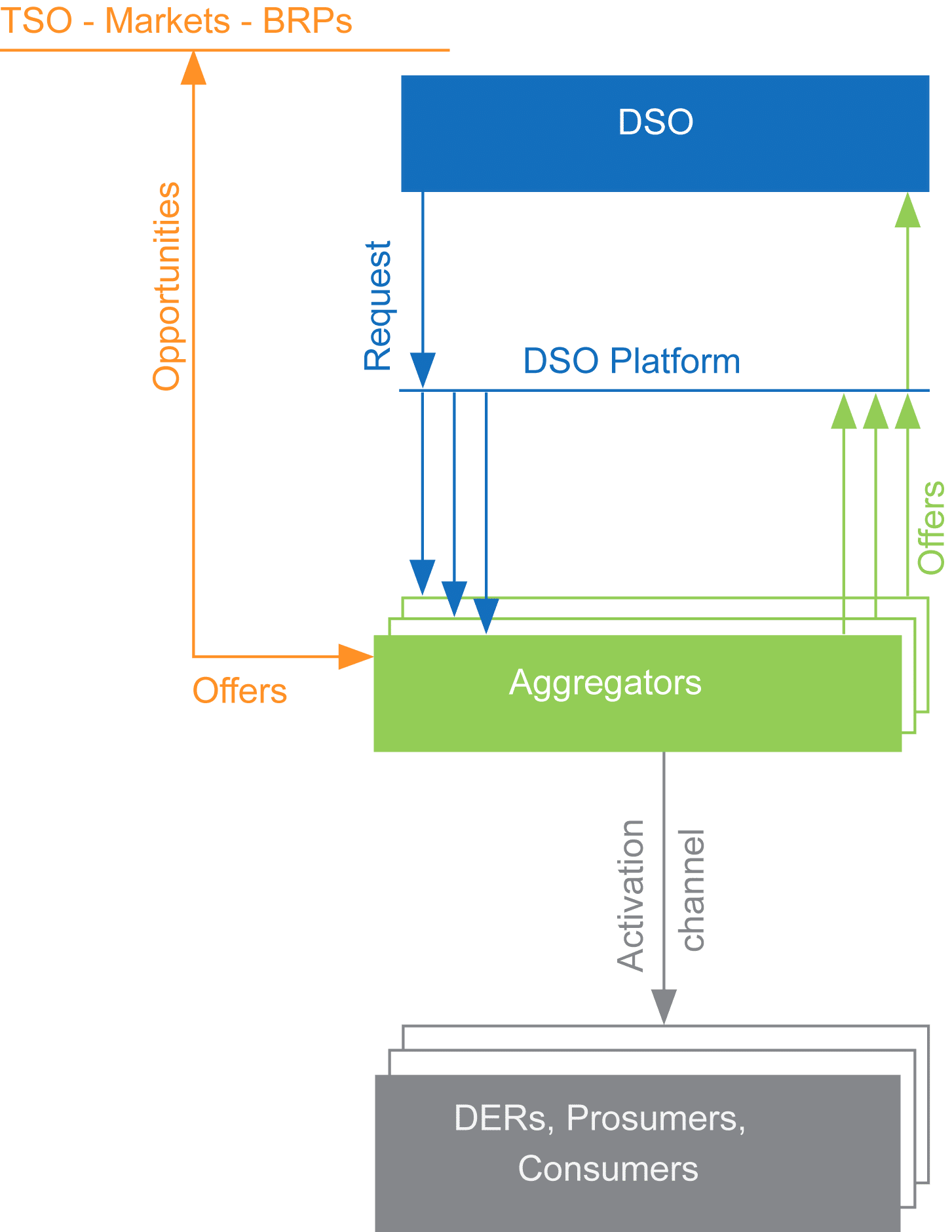LOCAL FLEXIBILITY MARKETS
In today’s energy world, national electricity markets are in place and are run by proven mechanisms in order to guarantee the security of supply and avoid congestion in the high-voltage grid.
Tomorrow, it could become similarly common to implement local flexibility markets in order to manage grid congestion and avoid or postpone reinforcements on the low or medium-voltage distribution level
BUSINESS CASE
InterFlex experimented the local trade of flexibilities for distribution grid purposes. In the French and the Dutch demonstrations, the respective DSOs developed dedicated IT platforms to share actual and potential flexibility demands with commercial service providers, the aggregators. The DSOs aimed at sourcing flexibilities on local markets to optimize the operational performance of the gridmanagement.
In the frame of both demonstrators, the actual degree of DER or EV development does not yet cause grid congestion problems. Prospective studies have therefore been conducted based on different scenarios to evaluate the potential DER and EV development. Forecasting tools on DSO and aggregator level have been developed and used to determine the expected impact on the distribution grid. The market mechanism tested in the French and the Dutch demonstrations is described hereunder.
When congestion was forecasted on the distribution grid, a flexibility request was sent via the IT platform to the aggregators. A flexibility request contains the requested flex power (up or down) for a given congestion point and the corresponding time slot. In the Dutch demo, the DSO also sent to aggregators the price it was willing to pay for such a request.
Flexibilities in the Dutch demo comprised a stationary battery, a controllable PV system as well as smart functions to manage the charging sequence of EVs in the demo area. In the French demo, a variety of flexibilities and activation channels were tested, including residential appliances, dual-fuel assets (gas/electric), industrial process control, stationary batteries and one EV with V2G capacities.
Upon receipt of a flexibility request, aggregators evaluated corresponding availabilities and sent bids based on their customer flexibility portfolio and the arbitrage opportunities on other markets or mechanisms considering their flexible ncapacity commitments towards the DSO.
The DSO analysed the offers from several aggregators and selected the most suited one(s). If there was a match between DSO demand and aggregator bids, the DSO sent its activation requests to the aggregators who dispatched them through specific activation channels to their flexibility providers. By doing so, the aggregators provided the expected flexibility service at the minimum cost.
The DSO’s formulation of flexibility requests, the bidding process as well as the flexibility activation process was channelled through both DSO and aggregator platforms and the corresponding interfaces.

DSO: Grid constraint management
Constraint forecast, flexibility service request, offer selection–settlement, service check after activation
Aggregators: Flexibility service providers
Customer recruitment, Forecast–portfolio optimization and balance, Procurement–dispatch between value pockets, Flexibility offer & activation
Customers: sources of flexibility
Technical offer specification–constraint criteria Contractual or spontaneous spot market offers
MAIN ACHIEVEMENTS
Flexibility mechanisms have been successfully set up, defining the roles of the respective stakeholders. IT Tools have been developed, including forecasting engines, market platforms and aggregator interfaces, some of them based on open protocols (USEF, EFI or CIM).
Concerted efforts on the market design of the traded products allowed to define formats to match the DSO’s requests with the aggregator offers, while identifying adequate time frames for the activation process.
CHALLENGES & RECOMMENDATIONS
The demonstrators highlighted that flexibility sourcing remains a critical element, especially at the early stage of the market development when flexibility value is low and the DSO’s flexibility demand remains sporadic and not easy to predict, thereby leading to potentially fragile aggregator business models and a lack of liquidity on the market.
The degree of both the local availability and the reliability of flexibilities represents a potential risk for the DSO who needs to rely on predictable means to achieve its performance objectives. Depending on the nature of the DSO’s flexibility request, there will most likely be a need for complementary markets: spot markets for opportunistic offers on the one side, versus reserve markets based on procurement contracts on the other side to secure the needed capacities.
In the current situation, conditions are not yet met in the demonstration areas to set up durable business models for local flexibility markets, as the distribution grid presents a very small number of constraints.
How can the local flexibility offer be stimulated? If the use of flexibility was to be generalized to foster an economically efficient and fair grid management, some temporary incentives may have to be put in place to allow aggregators and DSOs to move forward towards industrialised processes.
Meanwhile the DSO is not the only user of flexibilities. Multiple buyers can enhance the development of flexibility offers, whether they are local or not. As such, investigating the DSO-TSO coordination on flexibility procurement and the possibility of value stacking through sales on different markets and for different uses is a necessary next step.
In order to facilitate the generalized use of flexibility, market offers need to be standardised and regulation needs to be adapted and applied, in the perspective of an enhanced exploitation of the current and future electricity system assets. Regulatory frameworks are needed, defining simple mechanisms to foster the development of industrialised flexibility markets in the short term. Changing the taxationand tariff system including for instance variable network tariffs could in some countries be part of the measures to be taken to pave the way to the future use of (local) flexibility

